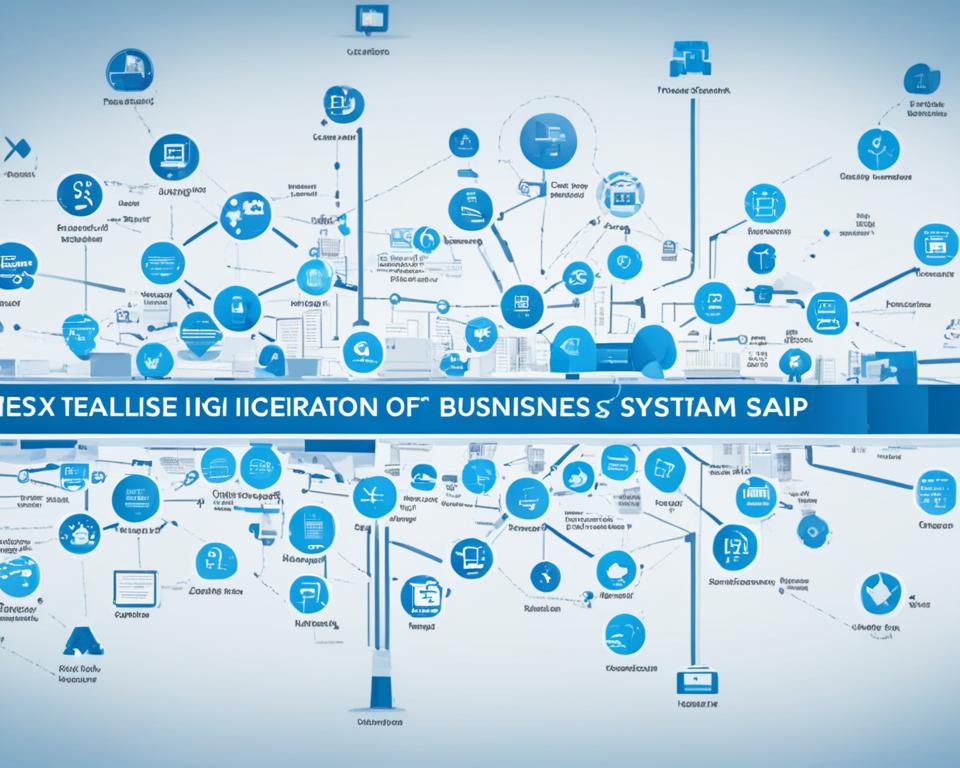Have you ever seen how some companies work so smoothly? They seem to do things effortlessly. The key to their success often is SAP XI, a tool for connecting different business systems together. I’ll explore how SAP XI boosts efficiency and manages data better. It helps different business apps work together better, leading to a smoother workflow that many companies aim for.
Key Takeaways
- SAP XI is essential for seamless integration of business systems.
- Improves operational efficiency and data management.
- Enhances collaboration among applications.
- Facilitates streamlined workflows in organizations.
- Helps avoid data silos and promotes better communication.
Understanding SAP XI: Overview and Benefits
SAP XI is a key platform that boosts business efficiency by connecting different business apps. It helps break down data barriers, which often slow down work. This makes it easier for companies to work together and run smoother.
The benefits of SAP XI are big. It makes sure data moves smoothly between systems. This leads to better teamwork and work flow. Using SAP XI also helps in making quicker decisions and boosts productivity.
In real life, SAP XI really shows its worth. For example, a recent project cut down on processing times a lot. This let teams spend more time on big projects and less on manual tasks.
Companies using SAP XI and Ariba can make their buying process better. This leads to saving money and getting a clear view of costs. With automated buying and easier bill handling, companies get more efficient. This helps them stay ahead in their markets.
To learn more about how Ariba works with SAP ERP, check out this resource.
| Key Features | Impact |
|---|---|
| Real-time Data Synchronization | Enhanced Decision-making |
| Centralized Procurement Management | Reduced Procurement Costs |
| Automated Sourcing Processes | Increased Operational Efficiency |
| Improved Supplier Negotiations | Better Spend Management |
By using SAP XI, businesses can get a big boost in efficiency and competitiveness. These features show the integration advantages of SAP XI. They also show how it can change the game in today’s business world.
The Role of Exchange Infrastructure in SAP XI
The Exchange Infrastructure is key to how business applications talk to each other and share data. In SAP XI, it has important SAP XI components that make sure systems work well together. Things like message transformation and routing are crucial for this.
This setup makes sure data moves smoothly between different platforms. It’s a big help for companies wanting to make their work flow better. SAP XI tackles integration problems, keeping things running smoothly and helping with better decisions.

Seeing how the Exchange Infrastructure is vital for a unified system landscape is clear. For more on how SAP systems and business process optimization work together, check out this in-depth resource. It’s a great guide for companies looking to use SAP to their advantage.
SAP Process Integration: Key Features and Functions
SAP Process Integration is key in the SAP XI framework. It gives businesses the tools they need to work better. Features like routing, message transformation, and protocol adaptation make handling data across different platforms easier.
One of the main functions of SAP Process Integration is making sure different applications talk to each other smoothly. It uses routing to make sure data gets to where it needs to go fast and right. This automation cuts down on manual work and mistakes.
Message transformation is also crucial. It lets companies change how data looks and what it means. This way, companies can keep data safe and right for their needs. It makes processes smoother and helps in making better decisions with correct info.
Looking at real examples, SAP Process Integration has helped many businesses. Companies using Ariba Sourcing and Supplier Management work better with suppliers and save money. An overview of SAP Ariba Modules shows how these solutions lead to smarter decisions and less risk with suppliers.
| Key Feature | Description | Benefits |
|---|---|---|
| Routing | Directs data from sender to receiver | Improved communication efficiency |
| Message Transformation | Adjusts data structure for compatibility | Ensures data integrity and accuracy |
| Protocol Adaptation | Supports various communication protocols | Flexibility in integration scenarios |
In summary, SAP Process Integration has important features that change how data is handled and automate business tasks. Mastering these functions can boost efficiency and open up new chances for companies aiming to improve their processes.
How SAP PI Facilitates Middleware Solutions
SAP PI is a key middleware solution that helps solve common integration problems for companies. It makes sure different systems talk to each other smoothly, making data exchange and processing efficient. As a central hub, SAP PI offers tools for changing data and managing it.
In real life, SAP PI makes complex IT setups simpler. For example, in industries with many software apps, SAP PI brings them together. The main benefits are:
- Improved Data Consistency: Makes sure all systems have the same data.
- Reduced Operational Costs: Automates data flows, cutting down on manual work.
- Enhanced Flexibility: Helps businesses quickly add new apps and adapt to changes.
From my experience, SAP PI really helps solve integration problems. It turns complex issues into easy-to-manage tasks. This solution is great at making data communication simpler and improving business operations.

Exploring Enterprise Application Integration via SAP XI
In today’s digital world, having good Enterprise Application Integration (EAI) is key for success. SAP XI helps by making sure different systems talk and share data smoothly. Getting systems to work together well is key for better efficiency and accurate data.
SAP XI is great because it supports data connectivity well. It lets different systems, old or new, share info easily. This is important for businesses to work better, cut down on waste, and share data well.
Here are some tips to make EAI with SAP XI better:
- Establish clear communication protocols: Having clear rules makes sure messages get sent safely between systems.
- Implement comprehensive monitoring: Watching data flows helps spot and fix problems fast.
- Leverage middleware solutions: Using middleware makes integrating systems easier and improves how they work together.
- Adopt a phased integration approach: Adding integration step by step helps manage the complexity, letting teams adjust as needed.
In conclusion, SAP XI is a strong tool for businesses to get better at Enterprise Application Integration. It helps with smooth data sharing and system working together. By following these tips, companies can get more efficient and do things better.
Message Mapping in SAP XI: Simplifying Data Transformation
Message mapping is key in SAP XI, helping to change data formats. It makes sure data moves smoothly between different systems. This process keeps data quality high during changes.

There are many ways to map messages, each making the process easier. I like graphical mapping because it shows connections clearly. It helps avoid mistakes and makes changes simpler.
- Graphical Mapping: User-friendly design with visual representations.
- Java Mapping: Greater flexibility for advanced transformations.
- Abstract Mapping: Optimal for maintaining separation of business logic.
Good message mapping makes data transformation better. It boosts efficiency and connects systems well. This cuts down on manual work. When I look at SAP Ariba, I see a big need for better managing of suppliers and procurement. This shows how important clear transformations are. For more info, check out sourcing solutions in SAP Ariba.
| Mapping Technique | Description | Use Case |
|---|---|---|
| Graphical Mapping | Visual representation for straightforward transformations | Common data integration tasks |
| Java Mapping | Custom logic implementations using Java code | Complex data processing |
| Abstract Mapping | Separation of mapping logic and data structure | Long-term maintainability solutions |
Using the right message mapping in SAP XI sets up a strong base for data transformation. This leads to better efficiency and smarter decisions.
Setting Up Communication Channels in SAP XI
In today’s world, having strong communication channels in SAP XI is key for smooth data flow. Knowing the different channels can make SAP XI work better and improve system performance. I will explain the various channels and how to set them up for the best results.
Types of Communication Channels
SAP XI has many channels for system integration. Picking the right ones is important for my business. The main types are:
- File: For sending data as flat files in different formats.
- HTTP: Good for web service communication over the internet.
- RFC: Connects SAP systems through Remote Function Calls.
- IDoc: A standard way to share data between SAP systems.
Configuring Communication for Optimal Performance
Setting up communication channels right is key for smooth data flow. To improve performance, follow these best practices:
- Pick the right channel types for the data and systems involved.
- Keep an eye on performance to spot any problems.
- Use error handling to fix issues fast.
- Make sure data is secure with proper authentication and security.
By doing this, my communication channels will work great. This means I can exchange data in real-time between different business systems.
| Channel Type | Use Case | Performance Considerations |
|---|---|---|
| File | Batch processing of data | File size and format can impact processing time. |
| HTTP | Web service calls | Network latency affects response time; optimize payload size. |
| RFC | SAP inter-system communication | Monitoring connection quality is critical for reliability. |
| IDoc | Data transfer between SAP systems | Volume of IDocs can impact processing load on systems. |
Data Transformation Techniques in SAP XI
In SAP XI, knowing how to transform data is key for top performance. These techniques help change data formats for better system communication. Learning about different transformation scenarios boosts data integration and reporting.
Understanding Transformation Scenarios
Transforming data means changing its format for sending it between systems. There are many transformation scenarios that show how to map data well. For example, changing XML to CSV needs special settings in SAP XI. Using pre-made templates makes this easier and more reliable.
Looking into these scenarios, I see how knowing the data’s context helps make better transformations. This meets specific business needs.
Best Practices for Effective Data Mapping
Good data mapping practices make transformations better and more reliable. Using tools like graphical mapping and XSLT helps see structures clearly. This makes spotting errors or quality issues easier.
Following these best practices makes SAP XI mapping more dependable. Here are some important tips:
- Document all mapping needs clearly.
- Use validation checks to keep data accurate.
- Check transformation processes often for ways to improve.
- Be ready to change as business needs change.
These strategies help with successful data transformations and keep data reliable. For more on SAP reporting, check out essential tips and tricks for ABAP reports.

Business Process Automation with SAP XI
In today’s fast-paced world, business process automation is key for companies wanting to boost productivity and make things run smoother. Using SAP XI applications brings big improvements to workflows. This leads to more efficiency gains and helps achieve operational excellence.
Automating tasks cuts down on mistakes and gives employees more time for important work. For instance, linking order processing with supply chain management via SAP XI can make things move faster. It also improves how well services are delivered.
- Find tasks that take a lot of time and often have mistakes.
- Use SAP XI apps to link systems and make data flow smoothly.
- Automate tasks step by step to watch how they perform and fix problems fast.
- Use analytics to see how automation affects productivity and efficiency.
By following these steps, companies can see big improvements. They get quicker decision-making, better teamwork, and happier customers. The way to operational excellence becomes clear as businesses use business process automation with SAP XI.
| Aspect | Before Automation | After Automation |
|---|---|---|
| Processing Time | Days | Minutes |
| Error Rate | 15% | 2% |
| Employee Engagement | Low | High |
| Customer Satisfaction | 75% | 95% |
System Landscape Integration Using SAP XI
Today, making systems work together smoothly is key for many companies. They want to make things run better and work more efficiently. SAP XI helps a lot in this area. It brings many benefits that can make integration work better. It’s important for companies to know these benefits and how to manage them well, especially as their needs change.
Benefits of Seamless System Integration
Using SAP XI for system integration can really boost productivity and flexibility. The main SAP XI benefits are:
- Enhanced data consistency across different systems
- Real-time data updates that help with quick decisions
- Lower costs from more efficient processes
- Following industry rules better with standard integration
Companies that use these benefits often see a better return on their investment. This shows how important SAP XI is for success.
Strategies for Effective Integration Management
To get the most out of system integration, strong strategies are needed. Here are some tips:
- Keep detailed records of how things are integrated to share knowledge
- Plan for growth with flexible architectures
- Have systems to check and fix problems fast
- Work together across departments to meet integration goals
With good management and planning, companies can make their system integration work better. This leads to smoother operations overall.

| Benefits | Impact |
|---|---|
| Enhanced Data Consistency | Better accuracy in reports and decisions |
| Real-Time Synchronization | Quicker responses to market changes |
| Reduced Operational Costs | Higher profit margins |
| Compliance Improvement | Lower risk of penalties and fines |
SAP XI: Best Practices for Implementation
Implementing SAP XI needs a structured plan for success. Following best practices boosts the chance of a successful setup. Project management is key, helping plan, do, and check the project from the start to the end. Getting everyone involved early helps everyone feel part of the team and makes changes smoother.
Change management is crucial for SAP XI implementation. Moving to a new system can be tough, so it’s important to look at the emotional and work impacts on staff. Training your team well prepares them for the new setup. I suggest having regular training and making resources like manuals and tutorials easy to find.
- Define clear objectives: Know what success means for your company.
- Plan comprehensively: Make a detailed plan with steps and deadlines.
- Engage stakeholders: Keep everyone who needs to know in the loop.
- Implement robust testing: Testing well helps avoid problems after you go live.
- Monitor progress: Check how you’re doing against your goals regularly.
Using platforms like Ariba Supplier Collaboration can also help. It can make buying and working with suppliers better, leading to more efficiency and saving money. This can make your project management even stronger.
By focusing on these best practices, many organizations have seen great results with SAP XI. Putting effort into the early stages of the project sets a solid base for success.
| Best Practice | Description |
|---|---|
| Define Clear Objectives | Set clear goals for your SAP XI project. |
| Comprehensive Planning | Make a detailed plan with steps and deadlines. |
| Stakeholder Engagement | Keep all who need to know updated and involved. |
| Robust Testing | Do thorough tests to make sure the system works right. |
| Progress Monitoring | Check progress often to stay on track with your goals. |
Challenges and Solutions in SAP XI Integration
In SAP XI integration, I often face challenges that can slow down projects. Data inconsistencies are a big problem, causing issues between systems. This can happen from wrong data mapping or systems not matching up well.
Also, mixing old systems with new ones can cause problems. These issues make the integration slow.
To fix these problems, I use strong integration solutions. These focus on careful planning and testing. Data validation is key to reducing errors when moving data. Testing before going live helps find and fix problems early.
Keeping detailed records helps track changes and understand how systems work.
Using a step-by-step approach to troubleshooting is vital. When I find common problems, I use specific methods to find the cause and fix it quickly. This way, I avoid future issues and make the integration smoother.
Looking back at past experiences helps me learn how to overcome integration challenges. I often check the ABAP Dictionary guide for tips on managing data. This helps me handle SAP XI integration better and get good results.
Conclusion
In this SAP XI summary, I’ve looked into its key role in improving business integration. I showed how SAP XI is essential for connecting systems, making operations smoother, and managing data better. It helps businesses streamline their processes and improve communication across different apps.
Reflecting on SAP XI, it’s clear it’s a must-have for companies wanting to succeed in the digital world. The growth of integration tech is changing business, and SAP XI helps companies use these changes to their advantage.
Using SAP XI in a broader strategy helps businesses deal with complex integration issues. It boosts agility, improves data flow, and lets companies quickly adapt to market changes. SAP XI will keep being vital in shaping business integration strategies. It helps companies stay competitive and efficient.



Leave a Reply